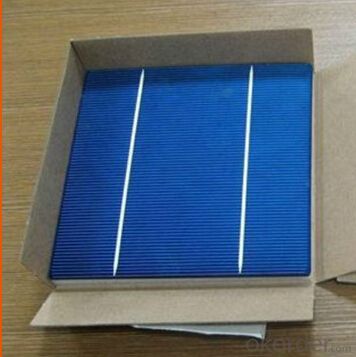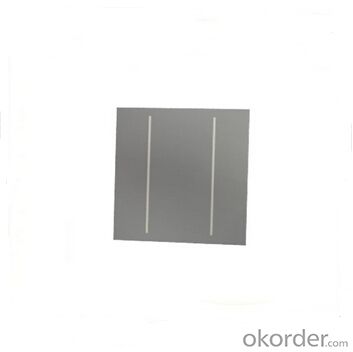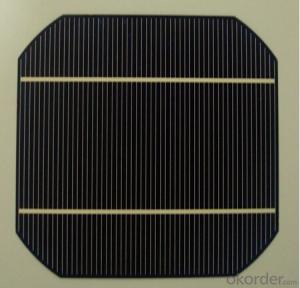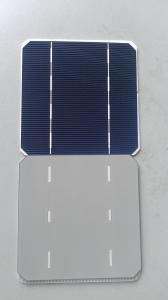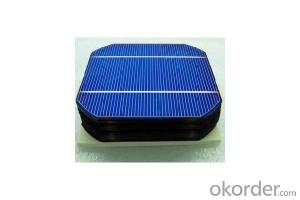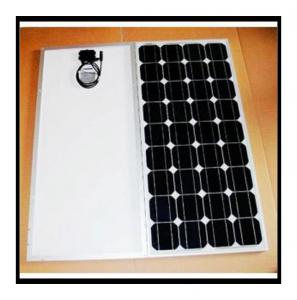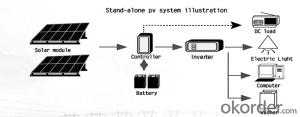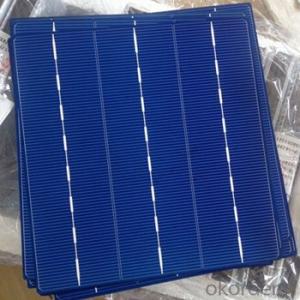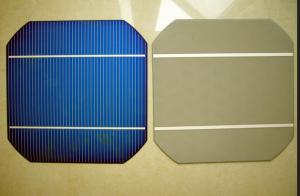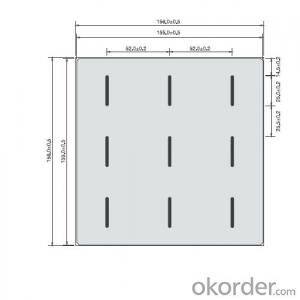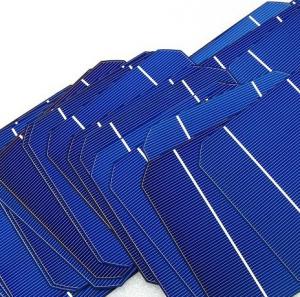Cheap Small Solar Cells - Monocrystalline Solar Cell 125mm×125mm±0.5mm
- Loading Port:
- Shanghai
- Payment Terms:
- TT OR LC
- Min Order Qty:
- 3000 PCS
- Supply Capability:
- 300000 PCS/month
OKorder Service Pledge
OKorder Financial Service
You Might Also Like
Solar Cells:
solar cells, when struck by photons of light from the sun, generates an electrical current which can then be used to power DC or AC electrical loads.
A solar cell is made of silicon. Computer chips are made of this same material. Basically, when light strikes the surface of a solar cell some of it is absorbed into the silicon. This light energy bumps the electrons loose and causes energy to flow
Solar cells is made by solar wafer, it has three categories of solar cell right now, monocrystalline polycrystalline and thin film,These cells are entirely based around the concept of PN junction, which is the critical part of solar module, it is the part that can convert the light energy into electricity, the thickness is from 180um to 200um, with even busbars to conduct electricity, textured cell can decrease diffuse reflection; they are often electrically connected and encapsulated as a module. Photovoltaic modules often have a sheet of glass on the front (sun up) side, allowing light to pass while protecting semiconductor wafers from abrasion and impact due to wind-driven debris, rain, hail, etc. Solar cells are also usually connected in series in modules, creating an additive voltage. Connecting cells in parallel will yield a higher current;With high quality and stable quality. Our Cells can greatly improve the performance of Solar Modules.
Features:
High efficiencies up to 16.4%
Proven long term mechanical stability of silicone
Make of highly purified poly silicone
Three bus bars for reduced series resistance and improved module and cell efficiency
Blue anti-reflecting coating ensures improved light absorption and increased efficiency
Acid texturization offers a uniform appearance and virtually invisible crystal structure
Excellent low light behavior for improved energy yield
Specifications
Dimension: | 125mm×125mm±0.5mm | |||||||||||
Diagonal: | 165mm±0.5mm | |||||||||||
Thickness(Si): | 200±20 μm | |||||||||||
Front(-) | Blue anti-reflecting coating (silicon nitride); | |||||||||||
1.6mmwide bus bars; | ||||||||||||
Distance between bus bars: 61mm . | ||||||||||||
Back(+) | Aluminum back surface field; | |||||||||||
2.5mm wide soldering pads; | ||||||||||||
Distance between bus bars :61mm . | ||||||||||||
Electrical Characteristics of mono solar cells 156x156 | ||||||||||||
Efficiency(%) | 19.4 | 19.2 | 19 | 18.8 | 18.6 | 18.4 | 18.2 | 18 | 17.8 | 17.6 | 17.4 | 17.2 |
Pmpp(W) | 2.97 | 2.94 | 2.91 | 2.88 | 2.85 | 2.82 | 2.79 | 2.76 | 2.73 | 2.7 | 2.67 | 2.62 |
Umpp(V) | 0.537 | 0.535 | 0.533 | 0.531 | 0.527 | 0.524 | 0.521 | 0.518 | 0.516 | 0.515 | 0.513 | 0.509 |
Impp(A) | 5.531 | 5.495 | 5.46 | 5.424 | 5.408 | 5.382 | 5.355 | 5.328 | 5.291 | 5.243 | 5.195 | 4.147 |
Uoc(V) | 0.637 | 0.637 | 0.636 | 0.635 | 0.633 | 0.63 | 0.629 | 0.629 | 0.628 | 0.626 | 0.626 | 0.625 |
Isc(A) | 5.888 | 5.876 | 5.862 | 5.848 | 5.839 | 5.826 | 5.809 | 5.791 | 5.779 | 5.756 | 5.293 | 5.144 |
Solar Cells Advantage:
1. High efficiency and High power.
2. Long-term electrical stability.
3. Lowest price and Fastest delivery.
4. Good quality and good service.
5.Bulk supply
6. Good Warranty
7.Big Sale
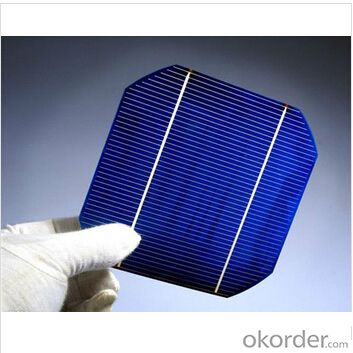
FAQ
We have organized several common questions for our clients,may help you sincerely:
1, What’s price per product ?
A: It’s depends on the quantity, delivery date and payment terms of the order. We can talk further about the detail price issue. Our products is high quality with lower price level.
2, How to make payment?
We accept T/T or L/C.
3, What is your lead time?
Generally 1-5 weeks depends on the order quantity and your specific requirements.
4, Can you do OEM for us?
Yes, we can.
5, How do you pack your products?
We have rich experience on how to pack the panels to make sure the safety on shipment when it arrives at the destination.
- Q: Can solar cells be used in emergency lighting?
- Yes, solar cells can be used in emergency lighting. Solar cells are capable of converting sunlight into electrical energy, which can be stored in batteries for later use. This makes them a reliable and sustainable option for emergency lighting, as they can provide power during power outages or in remote areas where traditional electricity sources may not be available.
- Q: What information can I get from the Internet about the solar cell modules? Such as what it is? How it is made?
- Solar cell module is actually a group of collections of solar cells, manufacutured in the same factory. With the solar cell modules, it can provide powerful energy that can generate large power for our daily or industrial use based on what we need.
- Q: How do solar cells handle high winds or hurricanes?
- Solar cells are designed to withstand high winds and hurricanes due to their robust construction and installation techniques. The panels are securely anchored to rooftops or mounted on sturdy frames, ensuring they can withstand strong winds. Additionally, solar panels are tested and rated for wind resistance, with most systems being rated to withstand wind speeds of up to 140 miles per hour. Therefore, solar cells are designed to handle high winds and hurricanes with minimal damage or risk of detachment.
- Q: How do solar cells perform in low-light conditions?
- Solar cells perform less efficiently in low-light conditions compared to bright sunlight. This is because they rely on sunlight to generate electricity through the photovoltaic effect. In low-light conditions, the reduced intensity of sunlight results in lower electrical output. However, advancements in solar cell technology have improved their ability to work under low-light conditions, allowing them to still produce some electricity even in cloudy or shaded environments.
- Q: How do solar cells affect the electricity grid?
- Solar cells can have both positive and negative impacts on the electricity grid. On one hand, they can contribute to a more sustainable and renewable energy mix by generating clean electricity directly from sunlight. This reduces the need for fossil fuel-based power generation, leading to a decrease in greenhouse gas emissions and air pollution. Solar cells can also help diversify the energy sources in the grid, making it more resilient and less dependent on imported energy. On the other hand, the intermittent nature of solar power can pose challenges to the stability and reliability of the electricity grid. Since solar cells only generate electricity when the sun is shining, their output fluctuates throughout the day and is absent during nighttime. This can create imbalances between electricity supply and demand, as the grid needs to ensure a constant and reliable power supply to consumers. Additional measures, such as energy storage systems or backup power sources, may be required to address these intermittency issues and maintain grid stability. Overall, the integration of solar cells into the electricity grid presents opportunities for cleaner energy generation and reduced reliance on fossil fuels, but it also necessitates careful planning and the implementation of appropriate grid management strategies to mitigate potential challenges.
- Q: What is Solar Cell Technology?
- A technology which converts the sun power into the electricity.
- Q: Can solar cells be used in space?
- Yes, solar cells can be used in space. In fact, they are commonly used in space missions to generate electricity from the sunlight in the absence of an atmosphere. Spacecraft and satellites often rely on solar cells to power their systems and equipment.
- Q: Can solar cells be used to power electronic devices?
- Yes, solar cells can be used to power electronic devices. Solar cells convert sunlight into electricity, which can be used to power a wide range of electronic devices such as calculators, smartphones, and even household appliances.
- Q: Is the Solar Power Photovoltaic Cells the same as PV cells modules?
- According to the size and scale of the photovoltaic power station, the PV modules can be composed of various sizes and different arrays.
- Q: Can solar cells be used for powering electric gates?
- Yes, solar cells can be used to power electric gates. Solar panels convert sunlight into electricity, which can be used to charge a battery or directly power the gate's motor. This allows the gate to operate without relying on the traditional power grid, making it more environmentally friendly and cost-effective in the long run.
Send your message to us
Cheap Small Solar Cells - Monocrystalline Solar Cell 125mm×125mm±0.5mm
- Loading Port:
- Shanghai
- Payment Terms:
- TT OR LC
- Min Order Qty:
- 3000 PCS
- Supply Capability:
- 300000 PCS/month
OKorder Service Pledge
OKorder Financial Service
Similar products
Hot products
Hot Searches
Related keywords


